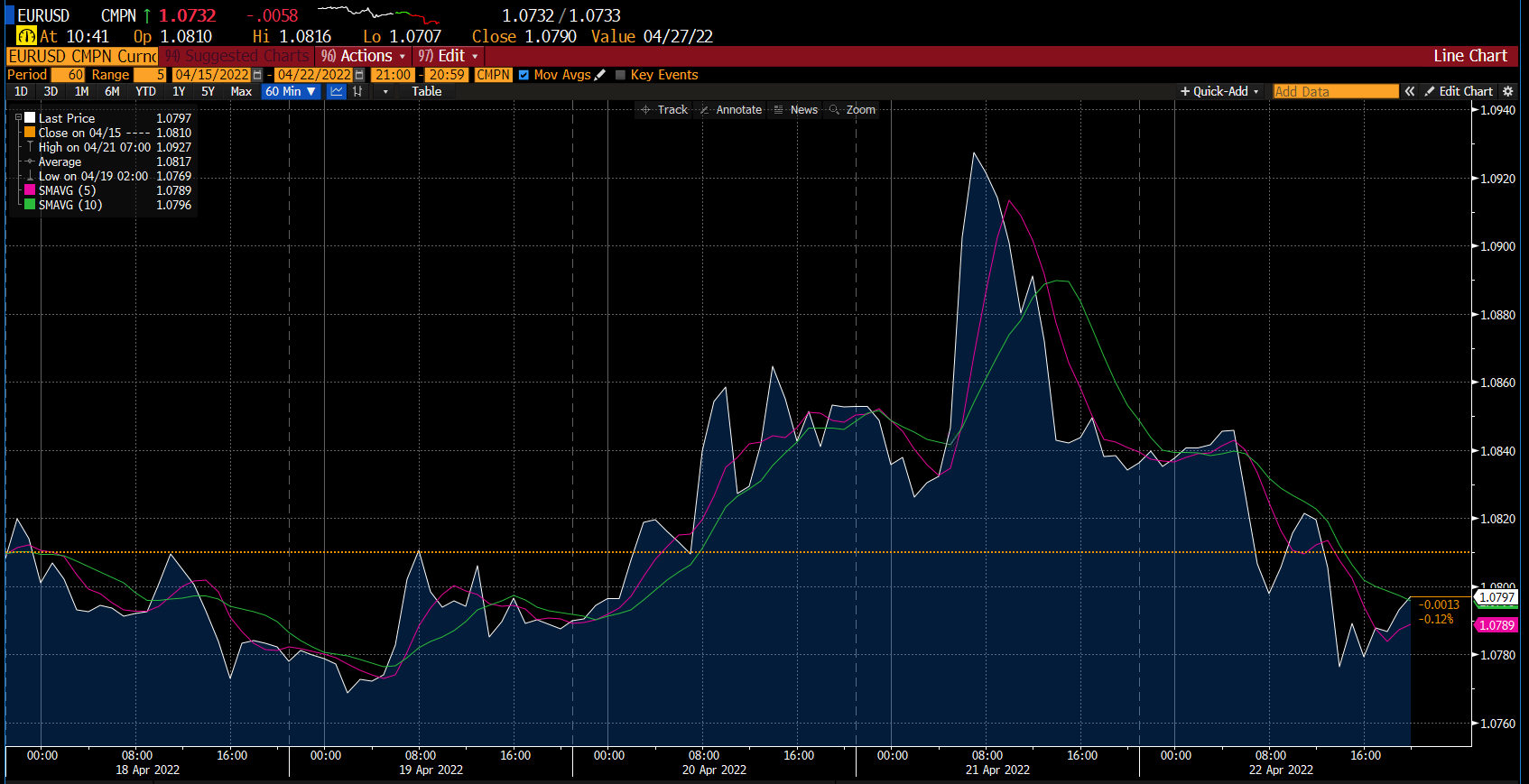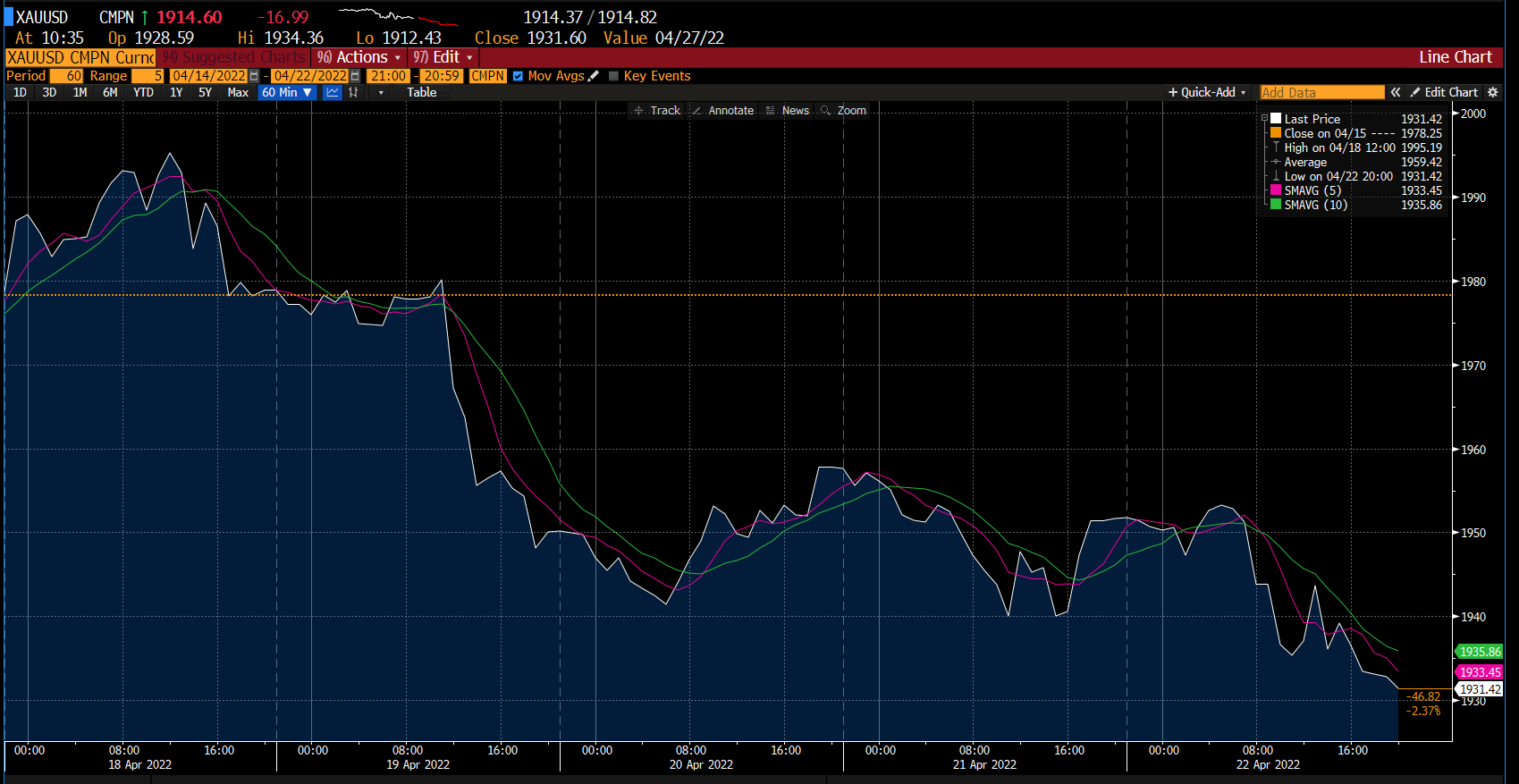Forex
Source: Bloomberg. Click to see full size
After reaching a high of $1.0936 on Thursday, 21 April 2022, the EUR/USD pair bounced for the second week in a row from around $1.0761 to settle near $1.08 for the week. On the week’s final trading day, risk concerns overshadowed positive macroeconomic developments, bringing the greenback back into favour.
The initial spike in the pair’s price was caused by an unexpected hawkish shift from some European policymakers. Luis de Guindos, Vice President of the European Central Bank said the inflation is close to a peak but a rate hike in the 2nd half of the year is feasible, depending on macroeconomic data.
Traders continued to desire safety amid concerns about a US recession and the Eastern European crisis, so the enthusiasm was short-lived. The yield on the 10-year Treasury note in the United States was under 3% this week. Additionally, inflation in the United States reached a four-decade high, touching 8.5% YoY in March. While in the European Union, inflation was verified at 7.4%, also a multi-decade record, but slightly lower than previously predicted. Here, inflationary expectations are stronger than macroeconomic indicators of easing price pressures.
Hawkishness among central bankers has become the new norm. Except for the Bank of Japan, virtually every central bank plans a more aggressive monetary policy tightening, which does not seem sufficient to contain the situation. Such a scenario creates an ideal ground for a US dollar rise, which will continue in the weeks ahead since none of the market’s bearish reasons are expected to fade anytime soon. High-yielding equities are also expected to fall, while US markets are expected to fare better since the US Federal Reserve has been laying the groundwork for an aggressive rate hike for a while, the majority of which has already been priced in.
It’s still unclear whether the European Central Bank (ECB) will act in July (as expected this week) or opt for a 25-bps or 50-bps hike, leading to the possibility of a short-term strengthening of the common currency.
As per the technicals, the hourly chart for the week seemed to be skewed to the right for the reasons mentioned above and is currently just above the 5 and 10 SMA’s at around $1.0789 and $1.0796, respectively. Also, EUR/USD was trading at its psychological level of around $1.0810 when it broke through the level on Wednesday, 20 April 2022 and traded at its highest level on Thursday, 21 April 2022. However, it fell below its psychological level towards the end of the week.
GBP/USD was down, ending the week at around the $1.2839 level and making the previous week’s rally appear to be a one-off in an ongoing trend. GBP bulls sought to regain the $1.31 level in the second half of the week, but the US dollar remained dominant. In the coming week, the pair will brace itself for critical US economic releases. However, the UK data releases appear to be relatively quiet.
Level up in your trading strategy with the latest market information and trade CFDs on the Deriv X Financial account.
Commodities
Source: Bloomberg. Click to see full size
Gold saw a change in the overall trend for the first time since the beginning of April. The trading conditions on Easter Monday gave way to a strong upward movement. As you can see in the chart above, the yellow metal started the week on a bullish note, reaching close to $2,000, its highest in over a month. Later, gold prices bounced around the psychological level of $1,980 before breaking free into a downward trend. The bullion saw a heavy decline on Tuesday, 19 April 2022, owing to dominating risk flows in the global financial markets.
Whilst the treasury yields and the greenback were lifted due to faster policy tightening by the Federal Reserve, the precious metal ended the week close to $1,930. Gold saw its biggest weekly decline since mid-March, having dropped below its SMA 5 and SMA 10, which now act as resistances. Overall, gold showed a similar decline against the US dollar and the Euro, having dropped by around 2.4% during the week.
The safe-haven asset is highly susceptible to the rising US short-term interest rates and higher yields, which increases the opportunity cost of holding non-yielding bullion. However, it is a safe place to park your funds during rising political and economic tensions.
Even though gold has come off its recent highs, inflation and geopolitical concerns continue to have a buoyant effect on gold prices. It’s only safe to say that gold should hold above the $1,900 level till there is a significant change in the Russia-Ukraine dispute.
Oil followed gold’s footsteps and added to its losses from last week. On Monday, 18 April 2022, oil prices dropped to nearly a two-week low due to the growing concerns over reduced fuel demand owing to the prolonged COVID-19 lockdowns in Shanghai. Overall, oil prices fell by nearly 4% last week.
Furthermore, crude oil prices are around $20 lower than last month’s peak. President Biden recently tapped into the Strategic Petroleum Reserve and reopened oil leases on public land. However, this development has not impacted the asset and fuel prices remain high.
As the Ukraine crisis deepens, oil prices are not expected to drop below the $90-a-barrel mark as the European Union weighs a ban on Russian oil. If that were to happen, the even shorter supply would catapult oil prices in the opposite direct.
Make the most of these market opportunities by sharpening your trading strategy and trade the financial markets with options and multipliers on DTrader.
Cryptocurrencies
Source: Bloomberg. Click to see full size
Bitcoin (BTC), the world’s largest crypto by market capitalisation, dipped below the $40,000 mark, while Ether plunged below the $3,000 level.
The rising correlation between BTC and stocks resulted in Bitcoin plunging more than 3% on Friday, 22 April 2022, when the US stock indexes fell. Powell’s speech from the previous night weighed on US markets and echoed on the cryptocurrency market, leaving an emerging breakaway from a critical support line. This movement is evident on the chart, where we see a dip in BTC/USD that dropped below the $39,500 mark after it reached its high for the week, which was above the $42,500 mark. Bitcoin then stayed along the lines for the rest of the week. Based on the hourly chart for the week, BTC/USD was at around $39,508, below the 5 and 10 SMA at around $39,564 and $39,603, respectively, which are currently acting as the resistance levels.
Furthermore, Ethereum was down by over 2.4%, while other leading altcoins in the top 10 were down by 0.4% (Terra) and 4.7% (Polkadot).
The total cryptocurrency market capitalisation, according to CoinMarketCap, fell overnight by 2.2% to $1.88 trillion.
Meanwhile, on Friday, 22 April 2022, Twitter Inc. announced that it is working with digital payment processor Stripe Inc. on a trial program for cryptocurrency payouts for its monetisation products. To reach out to the “creator economy” and boost revenue, Twitter added monetisation features last year. In addition to this, users who receive cryptocurrency payments can keep their earnings in crypto wallets on the Polygon network, a crypto infrastructure firm based on the Ethereum blockchain.
US Indices
|
Name of the index |
Friday’s close |
*Net Change |
*Net Change (%) |
|
Dow Jones Industrial (Wall Street 30) |
33,811.40 |
-600.29 |
-1.74% |
|
Nasdaq (US Tech 100) |
13,356.87 |
-553.89 |
-3.98% |
|
S&P 500 (US 500) |
4,271.78 |
-119.91 |
-2.73% |
Source: Bloomberg
*Net change and net change % are based on the weekly closing price change from Monday to Friday.
Stocks plunged on Friday, 22 April 2022, with the Dow Jones Industrial Average tumbling by more than 900 points and posting its worst day since 2020, as the latest weaker-than-expected corporate earnings and the prospect of rising rates caused a wave of selling.
The Dow notched its fourth consecutive weekly loss, and the S&P 500 posted its third. The Dow fell by 1.9% for the week, the S&P 500 fell by 2.8%, and the Nasdaq declined by 3.8%. Moreover, Goldman Sachs, Home Depot and Visa were big downside contributors.
In addition to reacting to the weaker-than-expected earnings reports, traders’ sentiment was influenced by the Federal Reserve’s tightening policy. Fed Reserve Chair Jerome Powell outlined his most aggressive approach to taming inflation and highlighted that a 50 basis point hike is on the table for May. Furthermore, the 10-year Treasury note yield rose to a fresh three-year high of just under 3% as the global bond market sell-off continued.
Earnings season is just getting underway, and results have been mixed across different sectors. Among these, Netflix, Inc. fell sharply after its unexpected subscriber decline weighed on the Communications Services sector, which was the worst performer of the week.
Next week may be the busiest of this corporate earnings season, with dozens of prominent companies across various market sectors reporting earnings. Apple, Amazon, Microsoft, Meta Platforms, and Google, the five of the largest technology companies, will report earnings in the upcoming week.
Now that you’re up-to-date on how the financial markets performed last week, you can improve your strategy and trade CFDs on Deriv MT5 Financial and Financial STP accounts.
Disclaimer:
Options trading, Deriv X Platform, and STP Financial Accounts on the MT5 platform are not available for clients residing in the EU.
This content is not intended for clients residing in the UK.



